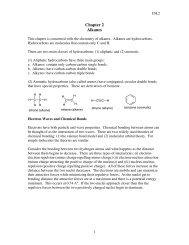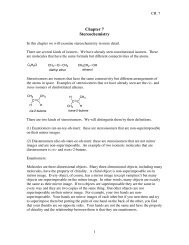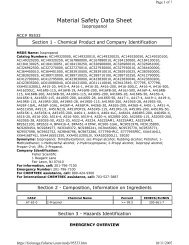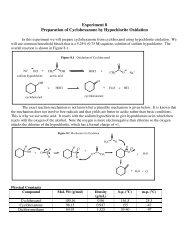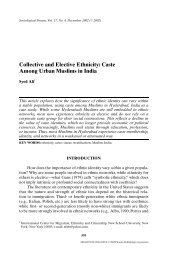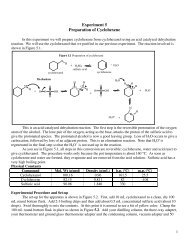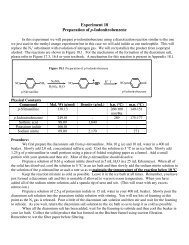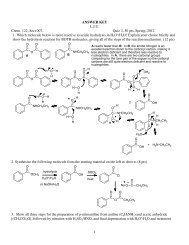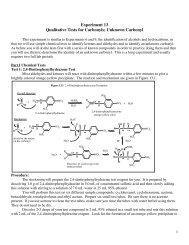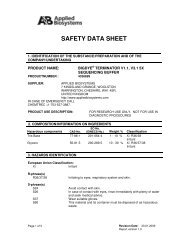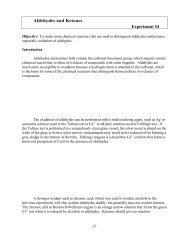Preparation and Properties of Soap - myweb
Preparation and Properties of Soap - myweb
Preparation and Properties of Soap - myweb
You also want an ePaper? Increase the reach of your titles
YUMPU automatically turns print PDFs into web optimized ePapers that Google loves.
get too hot, keep it just hot enough to have controlled boiling <strong>of</strong> the fat solution.<br />
6. While the saponification proceeds, prepare a salt solution by completely dissolving 20 g<br />
NaCl in 100 mL deionized water in a 250 mL beaker. After the salt completely dissolves,<br />
transfer about half <strong>of</strong> this salt solution to another beaker <strong>and</strong> place both beakers <strong>of</strong> salt<br />
solution on ice to cool them.<br />
7. After 30 min, test the fat solution to see if saponification is complete by placing a few<br />
drops <strong>of</strong> the solution in a test tube <strong>of</strong> deionized water. If you see fat droplets float to the<br />
top, the saponification is not complete <strong>and</strong> allow it to boil for an additional 10 min.<br />
8. When saponification is complete, carefully pour the hot reaction mixture into one beaker<br />
<strong>of</strong> salt solution <strong>and</strong> stir for a minute or two. Place the mixture on ice to cool it before<br />
filtering.<br />
9. Set up a suction filtration apparatus with a Buchner funnel <strong>and</strong> filter paper (see Appendix<br />
I for a diagram <strong>of</strong> the vacuum filtration apparatus). Filter the mixture from step 8, <strong>and</strong><br />
wash the soap (remaining in the Buchner funnel) twice with ice cold salt water (from the<br />
second beaker). Draw air through the soap for a few minutes to remove most <strong>of</strong> the<br />
water.<br />
10. Remove the soap cake from the Buchner funnel <strong>and</strong> save it for the following tests.<br />
Part B. Comparison <strong>of</strong> the <strong>Properties</strong> <strong>of</strong> <strong>Soap</strong> with Detergent.<br />
B-1. Alkalinity<br />
1. Prepare a 1% soap solution by dissolving about 0.5 g <strong>of</strong> the soap you just made in 50 mL<br />
<strong>of</strong> deionized water. It may help to heat the water to get the soap to dissolve completely.<br />
2. Use a glass stirring rod to place a drop <strong>of</strong> the soap solution on a piece <strong>of</strong> universal pH<br />
paper to determine whether the solution is alkaline, neutral or acid. Record your<br />
observation on the Report Sheet.<br />
3. Add about 5 mL <strong>of</strong> detergent (e.g., sodium laurylsulfate) solution to a beaker or test tube.<br />
You will compare this solution with your soap solution for the remaining tests.<br />
4. Test the detergent solution to see if it is alkaline, neutral or acidic by placing one drop <strong>of</strong><br />
the detergent solution on a strip <strong>of</strong> pH paper or red litmus paper. Record your<br />
observation on the Report Sheet.<br />
B-2. Lathering Power<br />
1. Add about 2 mL <strong>of</strong> deionized water to four large test tubes.<br />
57



